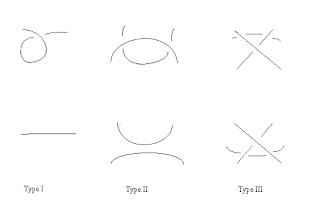Because mathematicians are always very creative people, things get names like as "the unknot" and "the unlink". If you remember the unknot (hint, it's the individual knots on the left and right in Figure 1), the unlink simply consists of two unknots (see Figure 1).
Alternatively, the Hopf link also consists of two unknots, but joined together (see Figure 2).
Figure 1 - The (splittable) unlink is made up of two unknots.
Figure 2 - The (unsplittable) Hopf link is also made up of two unknots.
At this point, you may think, well, it would be nice if we had a way to show exactly how linked two things were. Well, surprise, there is -- and it's called the linking number.
The way to find the linking number is, if you take a 2 component link and designate one as being on the left, and the other being on the right. Then, look at all the places the two cross. If the left one crosses over the right, add one to your total, and if the right one crosses over the left, subtract one from your total (Figure 3).

(+1)
Figure 3 - Calculating Linking Number
Then take this and divide by two. You have your linking number.
If you switch which component is on the left and right, you'll get either the positive or negative of the value. This is an invariant, because, no matter how you twist or turn the knot, the linking number will stay the same.
Unsurprisingly, the linking number of the unlink and the unknot is zero. Also, it is unaffected when the Reidemeister moves (from last week's post) are implemented onto the link.
Anyways, that's it for now. Thanks for keeping up, and see you next week!
References:
References:
Adams, Colin Conrad. The Knot Book. New York: W.H. Freeman, 1994. Print.
Bio.math.berkeley.edu,. N.p., 2016. Web. 27 Feb. 2016.
Exploring Optimal Nutrition,. "Exploring Optimal Nutrition". N.p., 2016. Web. 27 Feb. 2016.
Ndstudies.gov,. "3 - Venn Diagram | North Dakota Studies". N.p., 2016. Web. 27 Feb. 2016.
Upload.wikimedia.org,. N.p., 2016. Web. 27 Feb. 2016.













